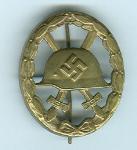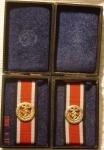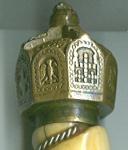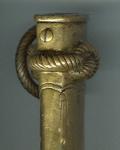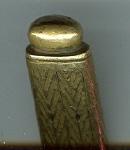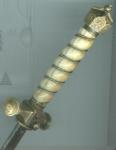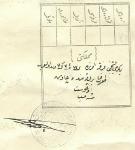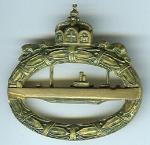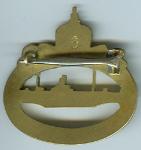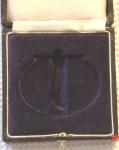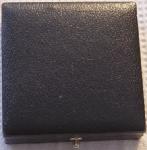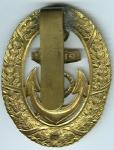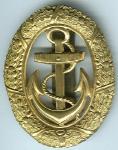
John Burchell
Valued Member-
Posts
285 -
Joined
-
Last visited
Content Type
Profiles
Forums
Blogs
Gallery
Events
Store
Everything posted by John Burchell
-
Pretty scarce wound badges...
John Burchell replied to Chris Boonzaier's topic in State, Civil Awards & Decorations
Here is a 1939 second type badge that I have had in my collection for awhile - apparently a brass "black" class intended to look like a gold class (although no traces of black paint remain as detectable to the eye). Note the round needle pin flattened with a twist in the middle. Perhaps a private purchase, as Don has mentioned above. Anyone seen one like this? Is it legit? Thanks, John -
Having further pursued my research on this dagger I would like to update accordingly. The very extensive 1999 publication by Thomas T. Wittmann, "Exploring the Dress Daggers of the German Navy" has provided a wealth of information of both photographic examples and text. I have also received additional opinion from collectors with specific knowledge of Imperial Navy daggers which I share with you below. The item pictured above is an original dagger in the 1890 Cadet Pattern which was adopted for officers in 1901. It would appear that this specific example is one of those produced in shorter lengths after 1902. Given the genuine "maidenhair" damascus blade and the lettering present on the side of the ricasso, it would appear to have been produced by the firm of Cark Eickhorn for the retail outlet store of "Aug. Luneburg, Kiel". The dedication reads in versioned translation: "Thiele to his good friend Hildebrand", which would indicate that Hildebrand wore the dagger. Taking into consideration the comments from Rick above, this point may be considered debatable. Additional input and comments from forum members is welcome and will be appreciated. Thanks!
-
Kriegsmarine Naval honour clasps..
John Burchell replied to Chris Boonzaier's topic in Wehrmacht Medals, Decorations & Awards
[attachmentid=60214]Somebody once referred to "the Canadian cache" of these clasps that were brought back by Canadian troops who ended-up in northern Germany at the end of the war...must be what you are referring to Chris. Here are my two examples. -
Here is a dagger which I have an opportunity to purchase. I am not knowledgeable on German daggers so am researching the piece to learn more about it, before making a decision. So far I understand this to be an Imperial Navy dagger or dirk, in particular, a presentation piece - given the inscription on the Damascus steel blade: "Thiele s/l. Hildebrand". The length of the blade is 8-7/8 inches; the overall dagger drawn from the sheath 13-7/8 inches; the scabbard alone 11-1/8 inches and the overall dagger in the scabbard 16-1/8 inches. There is no maker mark, however, there is some lettering on one side of the blade where it is thicker near the crossguard, much of which is illegible except for the final word ".....Kiel". The pommel is of the closed-crown variety. The grip appears to be genuine ivory exhibiting age-toning and hairline cracks, and it has tightly-wrapped twisted silver wire completely intact. The brass scabbard has a lightning-bolt pattern with rope-style mounts and rings. As the ivory grip seems to sit quite firmly in place once the pommel cap is removed, I have not taken this apart to examine the tang, for fear of doing some harm to the grip or wire wrap (I do not yet own this piece). My research led me to a thread on the WAF which listed KM Eichenlaubtraeger that included the name of August Thiele 26/08/1893 - 31/03/1981. Given his date of birth he would have been 21 years-of-age at the outbreak of WW1 and could well have re-enlisted and served during WW2, which leads me to wonder if this was the Thiele whose name appears on the blade. As well, I found a thread on the WAF where Michel posts an Imperial U-Boat badge that has the name "A. Thiele" scratched on the back, as well as his rank of "U. Ob. Matrose" (Obermatrose or Gefreiter per Rick Research). I am wondering if this is the same person. Can anyone please add to my knowledge and understanding of this dagger: - is it a so-called M-1890 model? - could it possibly be a Cadet dagger or dirk? - given the blade length, is it probable that it has been shortened? - from the Imperial Navy Ranklist can Thiele and Hildebrant be identified? - what would be a reasonable, current market price to pay for such an item? Thank you in advance for any comments and feedback. John
-
Here is mine. Same size as the one shown by Rick and, based upon the box in which it was mailed home (postmarked 21.12.17), must date from 1917 or earlier. As far as I understand, it was awarded to August Schempp from Lahr in Germany who was at the time with maintenance crew 057 of the Danube Artillery. This link provides all that I was able to learn, with the help of others: http://www.wehrmacht-awards.com/forums/sho...+War+Medal+1915 Here are some pictures. Any comments or feedback will be appreciated. Thanks, John
-
Kriegsmarine 1930s Maybauer u-boat badge
John Burchell replied to paul w's topic in Wehrmacht Medals, Decorations & Awards
Gordon, thank you for the quick response which is appreciated. As a further judgement and as you have suggested, I shall await possible further comments from Michel. -
Kriegsmarine U-190
John Burchell replied to Steve campbell's topic in Wehrmacht Medals, Decorations & Awards
[attachmentid=59705]As a Maritimer and collector of Third Reich militaria and history for quite some time, I have always been fascinated by the surrender of German U-Boats in Canadian waters. The U-190 was one of two German U-Boats which were taken into captivity following their surrender off the coast of Newfoundland at the end of WW2: the U-889 on May 10 and the U-190 on May 11, 1945. The U-889 was initially sighted by an American Liberator as she was proceeding on the surface flying a black flag. She was taken into captivity by two frigates of the Royal Canadian Navy and initially sailed to Shelburne, Nova Scotia where the formal surrender took place on May 13th. She was eventually turned-over the the U.S. Navy. Oberleutnant zur See Hans-Edwin Reith, Commander of the U-190, signed an unconditional surrender on May12th and the U-190 was escorted into Bay Bulls, Newfoundland by two RCN corvettes on May 14th. She subsequently sailed to St. John's, Newfoundland and Halifax, Nova Scotia. U-190 was later formally commissioned into the RCN and went on a ceremonial tour of duty and later assumed duties as an anti-submarine training vessel until she was scuttled off the coast of Nova Scotia in 1947 - but not before her periscope was salvaged! Newspaper reports earlier this year (2006) indicated that a marine archeologist and team of divers plan to search for the U-190. For those interested, the former Chief Engineer of the U-190, Werner Hirschmann, has written a book describing his wartime service and eventual capture aboard the submarine entitled: "Another Place, Another Time". Following the war, Mr. Hirschmann immigrated to the country where he spent time in captivity as a POW following the war and today lives in Toronto, Ontario, Canada. Hope this to be of interest. John -
Kriegsmarine Lunch with a Grey Wolf.
John Burchell replied to Gordon Williamson's topic in Wehrmacht Medals, Decorations & Awards
Simply having the pleasure of even meeting and talking with one of these fine gentlemen who survived is an honour in itself, aside from a great personal learning experience. Being able to compensate for such a privilege by restoring one of his badges is honourable, indeed. By the way, did you learn the name of the POW Camp in Canada where he was interned? John -
Kriegsmarine 1930s Maybauer u-boat badge
John Burchell replied to paul w's topic in Wehrmacht Medals, Decorations & Awards
I was pleased to see Paul W.'s WW1 Meybauer U-Boot badge in this thread, as I have been meaning to post mine for opinions, as well, so now seems to be an appropriate time. With consideration to the points kindly mentioned by Gordon W., I am encouraged by the fact that my badge has a smoothly finished reverse. The "fish tail" pin on mine is slightly shorter than that shown by Paul, but the hinge assembly appears to be the same, as does the Meybauer crest. With respect to the die characteristics of known genuine Meybauers, specifically the cross in the centre of the crown referenced by Gordon, I have measured the position of the horizontal cross bar on my badge and find that it does sit higher, ie. the top portion being 1.4mm and the lower portion being 1.8mm. Your opinion and comments on my badge would be greatly appreciated, Gordon and others. Thanks in advance. John -
1st Welsh Regiment
John Burchell replied to John Burchell's topic in Great Britain: Militaria: Badges, Uniforms & Equipment
Many thanks, Graham. This information puts the photo into a time context for all to read and appreciate. Regards, John -
Kriegsmarine Boxes, Boxes, Boxes!
John Burchell replied to Stogieman's topic in Wehrmacht Medals, Decorations & Awards
Thanks, Rick and as you indicate, it does make an excellent storage and showplace for my Schwerin that resides in it. Regarding my question on the maker(s) of KM Ehrentafel clasp award cases, in his excellent book, "The Iron Cross of 1939", Gordon Williamson in his section dealing with the army clasp describes the solid die-struck swastika one as being a pattern manufactured by Klein in Hanau, and shows a picture of the white flocked, removable base plate of the award case which has Klein maker-marks stamped into the white flocking, and comments upon that. Also shown in the section dealing with KM clasps is a typical Klein manufactured clasp, as well as an award case. However, there is no reference as to whether or not the pictured case was also produced by the same firm. Certainly, it does not bear the Klein maker-markings as shown for the army clasp. No other reference is made regarding who manufactured the KM clasp award cases, which I assume might have also been produced by the Klein/Hanau firm. I understand that Marcus has one maker-marked by Deschler. Perhaps Gordon or other knowledgeable members might provide some comment on the known manufacturers of KM Ehrentafel award cases, please? -
I do not collect these, but here for reference is a photo postcard of men from the 1st Welsh Regiment. Note the lettering on the washtub in front: "Ratty 7 Coy / 1st Welsh Regt". The reverse is blank, except for printed text "Post Card / For Inland Correspondence Only / Address Here". Perhaps one of the knowledgeable members can provide an approximate date for this picture and other details for all to read and enjoy? Thanks and regards, John
-
Kriegsmarine Watch officer badges
John Burchell replied to John R's topic in Wehrmacht Medals, Decorations & Awards
Judging from Gordon's comments above, ie.: "The postwar type made by Assmann for the Bundesmarine is the type with the single flat prong...." and "The main diference is in the finish which will be brighter..." also "The postwar ones usually have the Assmann "A" logo....", NOR/Andre's badge would appear to be Bundesmarine. The logo looks identical to the one on John R's postwar one above. I am hopeful that mine can hopefully be judged as being a period-repaired piece, with the wide flat (albeit shorter) prong having been added to replace the needle with lugs or clasp. John B. -
Kriegsmarine Boxes, Boxes, Boxes!
John Burchell replied to Stogieman's topic in Wehrmacht Medals, Decorations & Awards
And here is an award case fitted for a U-Boot badge. I am seeking comment upon the authenticity of this one, please. The "pillowing" in the inside upper cover does not glow, but the white cloth framing around the bottom between the rim of the case and the fitted portion (which I cannot remove) does glow. The hinge is non-magnetic; the push button clasp hardware is magnetic. Thanks, John -
Kriegsmarine Boxes, Boxes, Boxes!
John Burchell replied to Stogieman's topic in Wehrmacht Medals, Decorations & Awards
Allow me to add my two KM Ehrentafel Spange award cases for viewing and comment. I would like to know which company manufactured these? The hinges (magnetic), stencilling on the top outside covers, paper lining on the bottom interior and overall dimensions vary. Thanks, John -
Kriegsmarine Watch officer badges
John Burchell replied to John R's topic in Wehrmacht Medals, Decorations & Awards
[attachmentid=35468]Here is mine, for comments, please. I believe it to be a wartime period-repaired watch badge. It would appear that the original needle-type pin attachment hardware was replaced by a shorter, wide and flat prong. One can see in the 6 o'clock position where the retaining clasp for the earlier needle pin used to be. I believe that there is tomback showing through in a couple of the high-relief worn areas, eg. the bottom of the anchor. Regards, John

